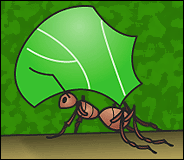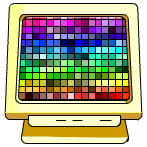Romulan Army Ants and Residual Cloning Efforts - A Preliminary Report (CAC Edition)
Created | Updated Mar 19, 2006
Submitted by Dr Radu Popescu for the use of Dr Celva Tanna and other interested parties

Phenomenon: The Romulan army ants - Formica romulensis - which have been living in the Arboretum on the CSS Mariposa since before the starship's acquisition by Confederation Starfleet - have begun exhibiting peculiar behaviour. The ants appear to be scavenging oddments of building materials - screws, pieces of plastic, the occasional nail - and taking them into their nests for purposes unknown. The reason for this behaviour is our first question.
The second question is this - why are some of the ants apparently in opposition to this undertaking? Why are they fighting amongst themselves - since they are apparently of the same species? What does this portend?
And finally, is this ant behaviour good or bad for the CSS Mariposa?
Parameters of Investigation
It would of course be desirable to observe the ants inside their nest in order to determine what use they are making of these zweckentfremdeten1 building materials. To that end, I propose to remove one of the nests in order to study it under laboratory conditions. The usual method is to set up the ant nest against a fiberglass wall, so that the tunnels may be observed. With proper lighting and temperature control, this disturbs the ants in no fashion.
Unfortunately, as we are the beginning of our quest here, we do not have the advantage of the results of such a study. I must therefore speculate - based upon my preliminary findings as to the nature of Romulan army ants in general, and my anatomical study of them so far.
A few factors must be kept in mind as you read the following - admittedly in many ways speculative - analysis, else the conclusions might seem to be fantastic on my part. One, an individual ant can carry up to 20 times its own body weight, but works in teams to carry much heavier loads. Their power to shift objects is therefore surprisingly great.
Two, the brain of even the most ordinary ant possesses mushroom-shaped appendages which function in much the same way as the grey matter of the human brain2.
Three, it is estimated that the brain of the ant possesses the computing power of a primitive computer3
In short, an ant colony is basically made up of a cooperative collection of units capable of data processing. Potentially, they form a linked network of computing units - I here take the liberty of coining the phrase 'internet' to describe such a network - which could potentially harness informational energy from the surrounding environment and put it to - what use, exactly?
That is what we wish to find out.
Physical Examination of Formica Romulensis
The examination was carried out in three stages - Kirlian photography, scanning, and genotyping. As this is only a sketchy preliminary report4, I will list only the results. Detailed data tables are of course available.
Time-lapse Kirlian photography yielded the following result - the ants in their motions follow patterns which - when their auras are photographed over time - produce images remarkably similar to HDEs5. A particularly spectacular pattern can be seen here.
Scanning produced the startling information that the internal structure of Formica romulensis is completely inconsistent with that of geomorphic ants. The creature is an astromorph6.
Scanning also produced data indicating that the field strength of a combined ant colony is simply amazing - and suggesting the possibility of linkage with other fields produced by astromorphic entities7.
Genotyping suggested a solution to the puzzling question of the struggle between some of the ant colonies, which appear to be trying to construct something, and other colonies, which appear to oppose them. While the aura-producing 'internet' of ant colonies are varied in their genome8, the oppositional ants are uniform in every detail.
In short, they are clones.
That such cloning of even so small a species as Formica romulensis is strictly forbidden by the Treaty of Vega Station goes without saying. A copy of this report will be sent immediately to Starfleet Headquarters and to the Enviropolice on Omicron 7 for further investigation.
Conclusions
1. The Romulan army ant is an astromorph.
2. The Romulan army ant is beneficial to the holosystem of the CSS Mariposa, as it is able to link with the astral engineering in some as yet undetermined way.
3. The oppositional army ants are clones. Somebody has broken the law.
Further Directions of Research
1. Study of the internal workings of the nest, in order to see what they are doing/making in there. Hypothesis - they are using extrinsic (i.e., non-holistic) materials from the ship to help stabilise the habitat and take some of the load off the astral engineer.
2. Further energy scans to determine the interaction of the ants with the other astromorphs aboard ship. Note - this will require the Captain's permission if we are to enlist the Gaels in such a study.
3. Investigation of the artificial (i.e., cloned) ant forms to determine if possible who has done this and why.
There are many interesting avenues of study which are opened up by this discovery. We stand on the threshold of a new understanding of the astromorphic lifeform and its role in the universe.

